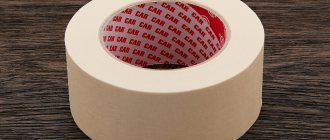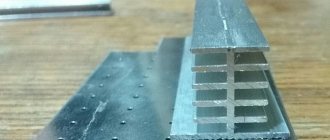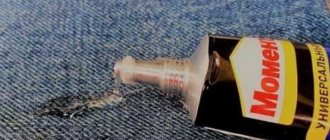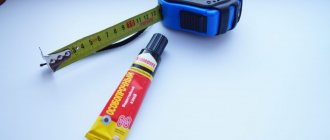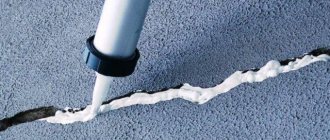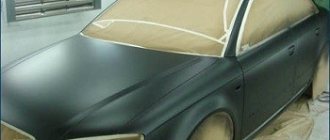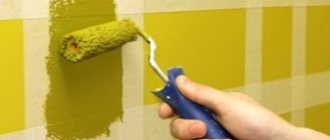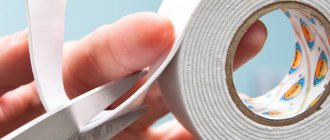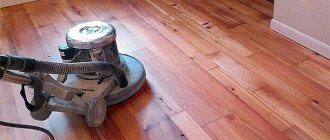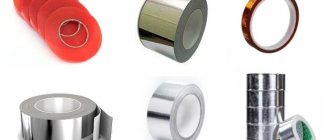When painting surfaces, masking tape is often used. It greatly facilitates the work, allowing you to obtain a clear boundary for separating colors. It is a tape of different widths, on one side of which an adhesive substance is applied. Having a huge number of advantages, masking tape has one significant drawback - sometimes it happens that it partially remains on the surface after attempting to remove it.
In such cases, you should immediately remove the masking tape. This is first done with a spatula or blade, being very careful not to scratch the surface. After removing the masking tape itself, marks often remain. Let's look at several ways to remove them.
Removal with another tape
If you didn’t waste time and after removing the tape, you immediately decided to remove all traces, then you can do this with another tape. The main thing is that the remaining glue does not have time to harden completely. This method is best used when working with plastic products.
Place the tape on the place where the marks remain and press well. Then with a quick movement you need to tear it off. Repeat several times to achieve the desired result. The advantage of this method over others is that it is absolutely impossible to scratch or damage the product in any way.
How to remove masking tape correctly
If the crepe-based adhesive tape was recently applied to the surface and has not yet dried, it will be easy to remove. To do this, you should not make sudden movements, but very smoothly, trying not to violate the integrity, pull it against the direction. Moreover, if small particles of the adhesive composition remain, then an oily liquid (vegetable oil or drying oil) can be used on smooth or rough hard surfaces. In this case, getting rid of the glue will be quite easy.
If the masking tape was applied a long time ago, and its natural moisture is kept to a minimum (both at the base and at the glue), then you will have to first soak the tape. Warm or hot water is used for this. Using a sponge or cloth soaked in it, soak the tape over the entire area and let it stand for a while. As soon as it swells, the dried adhesive composition will become more damp. Next, the tape is removed, and the resulting residues can be removed with any degreaser.
If there is a need to erase a small amount of marks, you can use a soft eraser.
If the crepe-based adhesive tape was recently applied to the surface and has not yet dried, it will be easy to remove.
Products containing alcohol
If you hesitate, and the glue has long been absorbed into the surface, you can try to remove it using alcohol-containing liquids. This can be ordinary vodka, alcohol, alcohol-based lotion (the lotion should not have color, otherwise it may adversely affect the surface being painted).
Soak a sponge or cloth in the liquid and carefully remove any traces of masking tape. First, this needs to be done in a place that is out of sight, since the result may not be the best, because not all types of plastic tolerate alcohol compounds equally well (deformation may occur or the color may change)
Tip: Rubbing alcohol is best for this purpose. After moistening the cloth and the glue remaining from the tape, wash it with detergent.
Removing dried adhesive residue from a wooden surface
Wood surfaces are very delicate and must be handled with great care. When cleaning wood, fat-based products (vegetable oils and even mayonnaise) are often used.
The most gentle way is oil
You can use vegetable oil or baby massage oil. Be sure to try it on the inside of the leg before using it.
Kitchen product
For cleaning wooden surfaces, the Cif kitchen cream is suitable; it is a thick, gel-like liquid with a soft cream color.
Eraser
A washing eraser is also suitable for cleaning delicate surfaces. Stains left by the eraser should be wiped with a dry soft cloth, then the shine will return to the furniture.
Important! Do not use the abrasive, hard side of the eraser - it will scratch the polish.
Non-aggressive detergents
You can remove traces of masking tape using detergents that do not contain aggressive substances. Choose them in gel, liquid or powder form (large crystals can scratch your surface, which will greatly detract from the appearance).
Soak a sponge in detergent and wipe the areas where the tape was, applying increased pressure directly to the glue accumulations. Even window spray will work for this purpose. Just spray it on the marks, wait 5-10 minutes and wipe with a sponge. After this, you need to rinse everything with clean water.
Table: what types of tape exist
| Type of tape | How to use | Base type | Does it leave marks? |
| Stationery adhesive tape | In offices, shops and schools for gluing paper and cardboard | Acrylic | No |
| Packing tape | In production for packaging products | Acrylic | Yes |
| Colored tape | In production for labeling different products in identical packaging boxes | Acrylic | Yes |
| Scotch tape with logo | In production as an additional advertising medium | Acrylic | No |
| Masking tape (crepp) | To protect the surface from construction work | Rubber | No |
| Reinforced adhesive tape | For various repair work, waterproof | Rubber | Yes |
| Double-sided tape | Holds two objects together | Acrylic | Yes |
| Mounting rubber thick tape | For fixing plexiglass | Acrylic | No |
Removal with a hair dryer
If the item to be painted is made of a material that is resistant to elevated temperatures, then traces of tape can be removed with a regular hairdryer or steamer. It is enough to heat just the end of the tape, and then pull it, and it will all come off easily. Remaining glue should not be heated too much; after a slight increase in temperature, they can be easily removed with a damp cloth.
A faster option is to go by ferry. Sometimes it’s enough just to breathe for a long time and then wipe off the marks.
How to wash natural or synthetic fabrics
As soon as you find traces of adhesive tape on fabrics, begin to act immediately, before the glue hardens and is absorbed into the fibers of the fabric.
Alcohol or acetone
You need to moisten a cotton swab or a cotton pad folded in half with solvent (use the corner of it) and wipe the dirty mark. The solvent can be used on durable, non-fading fabrics, but it is not at all suitable for printed or patterned fabrics, dyed fabrics and thin material.
Acetone dissolves tape adhesive
Soap solution, washing powder or soda solution
You need to soak the clothes for half an hour to an hour, and then rinse, first of all paying attention to areas with traces of adhesive tape and carefully removing the glue from the fabric with your hands.
Washing machine
Try washing things in a washing machine, setting it to a specific mode for each specific type of fabric. It is advisable not to set the spin program after washing - this way you will have the opportunity to check whether the adhesive tape remains on the surface of the fabric or not.
Gasoline, kerosene, and other oil-based solvents leave permanent greasy stains on fabrics, so using them to remove tape from clothes is not recommended at all.
What should not be used to remove tape marks?
Some substances can damage the surface of the product, although they will help remove traces of glue. These include:
- Substances in the form of powders with large granules. They can scratch the polish.
- Substances containing aggressive components or acids. They can react with the plastic, changing its color or shape.
Thus, there are many ways to remove residual tape, so you can easily choose the one that is suitable for your surface.
Choose the best method
At first glance, the task of removing adhesive tape is simple. But the cleaning tools and materials used may vary and ultimately affect the cost of the process.
Why isn't there one universal method for removing tape?
It should be understood that different options for cleaning methods
- wood,
- glass,
- plastic,
- metal,
both with and without coating, are determined by the structural nuances of the adhesive composition and the characteristics of the products being cleaned.
With numerous standard options for problematic surfaces, such as home windows and doors, car bodies and interior trim parts, everything is more or less clear. These materials are familiar to everyone and quite predictable.
Whereas with the main adhesives (rubber, acrylic, silicone) everything is very complicated. Manufacturers are in no hurry to disclose their developments to the public. Because of this, the method of removing acrylic masking tape from one manufacturer may not work when similarly processing similar materials from another brand.
All significant differences are due to the fact that the adhesive compositions described above have different values of residual adhesion and thermal activity. Even at room temperature, they do not harden immediately, but after some time: from 30 minutes to 90 days. As the temperature of the working medium changes, the reaction rate also changes.
It is difficult to guess at what exact stage the glue is located that contributed to the problem. It was necessary to check (compare the behavior of different versions of adhesive tape) before starting work. Then it is quite difficult to do this. This only means that certain conditions recommended by the manufacturer were violated.
There is only one solution - to start treating problem areas with the gentlest methods, in the most inconspicuous places.
How to clean double sided?
You can remove double-sided tape from surfaces using acetone. Chemical cleaning methods allow you to cope with the problem.
To do this, you can use devices such as:
- stationery knife;
- drill or screwdriver with a rubber attachment;
- a hairdryer used to heat up the tape;
- masking tape.
Remains of glue are removed with an eraser or vegetable oil. You can read more details here.
Removing masking tape and its traces
Lift the corner of the glued tape and, tilting it 1800 from its original position, pull with even force. Thus, any masking tape that has been selected and applied in accordance with the manufacturer’s recommendations can be removed easily and effortlessly.
Otherwise, masking tape removal is accomplished 96% of the time using a commonly available tool. Highly specialized devices will also be discussed below. But first, it’s advisable to try what you always have on hand. Those materials that can be purchased quickly and inexpensively are also acceptable.
Entry level tool
- a roll of fresh masking tape 30 mm wide (from 150 rubles);
- a sheet of sandpaper or a sanding sponge with 400 grit (from 50 rubles);
- a block of elastic rubber in any form - an eraser, a valve from a tubeless wheel, a part of a rubber band, which is used for preventive repair of shoes. The main thing is that it is comfortable to hold (from 30 rubles);
- artistic brush with fine bristles (from 15 rubles);
- a package of cotton pads or soft, highly absorbent fabric (up to 50 rubles).
It is necessary to remove the masking tape from the surface after painting after 3-4 hours. If it dries completely, the paint may come off along with the tape, so it is not recommended to wait too long
Cleaning rules depending on the type of surface
The choice of cleaning agent should be based on the material from which the furniture is made.
Glass surfaces
Glass surfaces can withstand intense chemical exposure . They can be processed:
- soap products,
- alcohol-containing compounds;
- special aerosols for removing glue.
Stationery tape can be washed off with regular soap. Double-sided adhesive tape, or rather traces of it, can be removed from the surface with chemical compounds.
You cannot heat the glass with a hairdryer. Cleaning with a drill is prohibited. These methods can lead to the glass simply cracking.
It is not advisable to clean glass with powder and soda, since these products consist of small particles that can cause minor scratches.
Read more about removing tape marks from glass surfaces here.
Wood materials: painted or polished
Painted or polished wood can be cleaned:
- oil,
- soda,
- eraser
- or liquid detergent (if applied very carefully).
It is not advisable to heat the wood and apply special sprays to it (only in case of severe contamination from double-sided tape).
It is strictly prohibited to wash wooden coverings using solvents or alcohol-based products , as this will lead to damage to the covering.
Plastic
Plastic furniture can be cleaned using a variety of cleaning products. It is undesirable to use only dry cleaning agents and soda - scratches may remain. However, the concept of plastic is very broad, in some cases it is a rather capricious and delicate material.
In order not to spoil the plastic product, before starting full cleaning, you should definitely try the selected product on an inconspicuous small area of the surface.
Stationery tape can be removed by soaking it with soapy water. It is better to remove strong double-sided tape with a spray.
Learn more about removing tape marks from plastic surfaces in this article.
Cushioned furniture
Upholstered furniture can be tidied up using :
- soap solutions,
- detergent,
- special sprays.
For severe dirt, you can heat it with a hairdryer. It is better not to use a solvent - if it does not corrode the material, it will be absorbed into it and the furniture will smell bad.
It is also undesirable to use tooth powder , since it is difficult to wash out from fabric surfaces and may leave a whitish trace.
Cleaning tape from wallpaper
The method for removing adhesive contamination will depend on the type of wallpaper:
- If the canvases are made of vinyl or silk, and they are not fibrous, then no dirt from the adhesive tape will remain on them.
- If the wallpaper is paper, then the adhesive from the tape will most likely remain. To clean it, the canvas must first be heated with a lamp or hairdryer, and then wipe the area with a dry cloth. The same can be done with other types of wallpaper.
Work must be carried out extremely carefully so as not to damage the canvas. Special problems usually do not arise with non-woven, vinyl and other types of wallpaper, which have a denser structure than traditional paper products. Paper webs are usually very thin, so traces of glue must be removed from them carefully so as not to damage the material itself.
Video description
How to remove traces of tape.
Caustic soda
Before you start cleaning the surface, you need to prepare a saturated caustic solution. Then, using a sponge, apply it to the contaminated areas, and after a minute, remove it with a dry cloth.
In order to clean the surface from traces of adhesive tape using caustic soda, you need to prepare a concentrated solution of it Source hoznauka.ru
Toothpaste
Suitable for all types of wooden furniture, except polished. The paste-like composition must be diluted in a small amount of water, then applied to the surface with a cotton pad. After 5 minutes, the treated area should be rinsed with warm water and wiped dry with a cloth.
How to remove tape from glass
Glass, like metal, is highly resistant, and therefore can be cleaned using:
- Gasoline.
- Soapy water solutions.
- Solvents.
- Soda.
- Essential oils.
- Acetone.
- Alcohol.
The only rule here is that you should never use powder. All this is due to the fact that the powder scratches the glass greatly.
General tips and tricks
To avoid damaging the skin of your hands with aggressive substances, you need to wear gloves.- When interacting with liquids that have a strong chemical odor, it is recommended to protect your respiratory system with a respirator.
- If you don’t have a hairdryer at hand to heat the surface, you can expose it to the sun’s rays. They will melt the glue, making it easier to remove.
- You should not start treating a large surface with aggressive agents if you are not sure of the success of the event. In order not to spoil the thing, you need to try to test the selected product on an inconspicuous area. Only after this can you begin further cleaning.
Video description
Easily remove the tape from the glass.
How to remove adhesive from tape from metal
To effectively remove dirt from a metal surface, it is advisable to use:
- Freezing method. Place some ice in a plastic bag, which is then applied to the contaminated base. After 20 minutes, all dirt can be easily removed with a hard plastic brush or wiped off with a rough cloth.
- Special chemicals.
- Windscreen wipers. After applying them, the base is immediately wiped with a dry cloth.
- Any alcohol-containing liquids. A rag is soaked in one of these solutions, then the surface is thoroughly wiped until unwanted marks are completely removed. The resulting divorces are disposed of in the same way.
To remove adhesive from adhesive tape from metal coatings, it is unacceptable to use abrasive special tools or mechanical methods. After contact with an abrasive, microcracks often form on the metal and it loses its shine.
How to wipe off tape: the best methods and means
Adhesive tape is made from different materials, such as construction tape and painting tape. Acrylic glue is usually used for it. The cleaning method is selected based on this fact. The most effective means:
- the same adhesive tape;
- sunflower or essential oil;
- pencil eraser (it will take a lot of effort and patience, especially if there is a large area of dirt);
- ethyl alcohol or vodka;
- purchased aerosols;
- petrol;
- soapy water;
- powder cleaner.
The choice of technique depends on the material on which marks need to be removed.
Removing marks with new tape
This cleaning method works on the wedge by wedge principle. You need to glue fresh tape to the surface with the marks and quickly tear it off. Often the old glue comes off the first time, sometimes you have to repeat the procedure several times. This removal method is suitable if you need to remove very few stains on plastic. As for cleaning glass, this method may be successful, but only if the original tape was less sticky than the one used for cleaning.
Oil dissolution
Almost any vegetable oil can dissolve traces of tape. It can be essential, sunflower, olive or any pharmaceutical oil. This method is one of the most effective and can be used on absolutely any surface, be it metal, plastic or glass.
The contaminated area is rubbed with oil and left for 10-15 minutes. Oil and glue are completely incompatible, so the latter begins to foam and come off. Thanks to this, it can be erased with little effort. The only drawback of the method is that you will have to wash the surface later to remove grease, but this will be easier.
Using oil, you can even tear off old tape, which breaks into thin ribbons when you try to remove it. You need to saturate the tape along the edges, then slowly tear it off little by little, periodically adding oil to the exposed areas.
Liquid soap
It will only remove fresh dirt. It is useless for the old one to use it. Any of the options will do: solid or liquid soap, dishwashing liquid, body gel, shampoo, etc. A small amount is dissolved in warm (or preferably hot) water. Apply to adhesive paste and rub a little. Leave for a while and repeat. Gradually, the contamination becomes loose and is washed off.
Detergents
It is necessary to prepare a solution from powder or any liquid detergent, for example, for dishes. It is added to warm water and foamed well. The resulting solution is used to treat the problem area.
Food vinegar
The acidic environment helps remove fresh and old stains. To increase the strength of acetic acid on the adhesive residue from the tape, you need to let the applied liquid sit for a couple of minutes. After the specified time, the surface can be cleaned exclusively with a dry cloth, since moisture slightly reduces the effectiveness of cleaning.
The acidic environment allows you to completely remove both fresh and old stains from adhesive tape from the surface. Source dachadecor.ru
Eraser
The eraser easily removes stains that have not yet become ingrained. It leaves no traces behind, so it is great for reading dark and light surfaces. Does not affect their structure or color in any way.
There is nothing complicated in cleaning: you just need to rub the sticky layer. Most of the dirt will be wiped off with ease. If any stains remain, it is best to further treat the surface with soap and water.
Cleaning with an eraser takes a long time. The rubber band can be replaced with a drill attachment or a nipple for tubeless tires.
Antistatic
An antistatic agent will help get rid of traces of adhesive tape on the refrigerator, stove and other equipment. The spray effectively dissolves glue stains without leaving marks on the surface. Apply a little mixture to the contaminated area and leave for 3-5 minutes. Then remove the residue with a damp cloth.
Petrol
Gasoline vapors have a negative impact on human health, so cleaning with these harmful substances must be carried out in compliance with safety regulations. In the room you need to open the vents and windows, wear a respirator or gauze mask (so that the vapors do not penetrate the respiratory system and provoke pathological conditions), gloves (so that the chemicals do not burn the skin on your hands). Then you can start scrubbing off the tape, to do this:
- gasoline is applied to thick fabric in a small amount;
- The material is rubbed onto the contaminated area.
The chemicals dissolve the adhesive on the surface and clean it instantly. After wiping off the tape, the previously contaminated area should be thoroughly washed with soap and water.
Soapy water
Water with soap or powder dissolved in it can remove traces of glue that have not yet become thoroughly embedded in the surface. The solution will help clean fabric, plastic, aluminum, and painted metal.
Cleaning method:
- grate 1/4 of the laundry soap on a medium grater;
- dissolve the shavings in a glass of water;
- moisten a foam sponge in the solution and thoroughly wipe the contaminated area.
When marks need to be removed from clothing, it is soaked in the product for thirty minutes. After this, wash by hand. The soap solution also removes greasy stains and paint residues from fabrics.
Alcohol
Ethyl, ammonia or methyl alcohol, as well as alcohol-containing compounds, will work effectively. For example, glass cleaning fluids, vodka and similar products. Even wet alcohol wipes will do. True, the effectiveness of the latter is low. Wipe the problem area with a sponge or rag soaked in the solution and leave for a while. After 5-6 minutes, remove the dirt with a napkin.
Waterproof makeup removers
Another alternative method for removing tape is waterproof makeup remover.
It is enough to apply a small amount of micellar water to a cotton sponge or a small piece of cloth and wipe the dirty surface. The method is suitable for removing small stains.
Why does tape stick to surfaces and leave marks?
Scotch tape is a tape with a layer of adhesive applied to it. Synthetic or fabric backing is available in various widths and thicknesses. For household tape, cheaper acrylic-based glue is used. Special types of adhesives, for example, for electrical insulation, include rubber and other components. When removing the tape, part of the sticky layer may remain on the surface.
This mainly applies to inexpensive brands. With high-quality adhesive tape, the adhesive strip adheres well to the base and does not separate from it.
Sometimes the glue literally fuses with the surface as a result of chemical interaction. Then it is especially difficult to clean it. Since glue marks collect dirt, they need to be removed as quickly as possible. Take into account the composition of the adhesive and the quality of the surface.
You can use professional tools
Unlike some tools, using professional chemicals for removing adhesives is very simple and convenient. But it costs from 400 rubles for an aerosol can with a volume of 400 ml. Depending on the degree of surface contamination, up to 4 cylinders can be used per 1 m2 of area.
About 1,600 rubles are spent in half an hour. This is the most expensive option when removing the tape yourself.
However, from the point of view of the results obtained on products made of plastic, glass, painted metal and wood, highly specialized professional compounds are worthy of attention.
Whereas from the point of view of profitability, the loss of money and time that you will have to spend on the correct selection and search for suitable materials is not always justified. Additional costs should be planned both at the stage of self-study and in the process of performing one-time work.
In the case of particularly large volumes, when due to someone’s carelessness it is necessary to clean all the windows and doors of the facility, you must be prepared for a further increase in costs, but not only for materials and equipment. You will need both high-performance ventilation equipment and a full set of highly specialized personal protective equipment.
Basic rules
What not to do in the fight against adhesive traces:
- use finely dispersed materials: they themselves will stick to the marks and interfere with their removal;
- use metal scrapers: the plastic will be scratched;
- overdo it with solvents: the plastic will dissolve along with the glue.
Remember: the fresher the sticky mark, the easier it is to remove.
Important! Abrasive powders, hard brushes, and corrosive chemicals are contraindicated for plastic.
